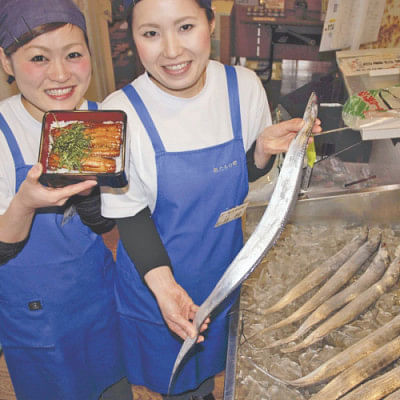STONE BUDDHAS of Kunisaki Peninsula

THE uneven stone steps - built by demons according to legend - increase in steepness as they rise, as if they are trying to block my ascent. I did not expect such an ordeal would start on the mountain road to the Kumano Magaibutsu stone Buddha reliefs, the first destination on my trip around the Kunisaki Peninsula in Oita Prefecture.
Is it bad karma for my lifestyle full of worldly desires? I tried to soothe my screaming feet and calmed my breath. As I looked up, a wonderful scene came into view.
Two Buddha statues can be seen on a protruding cliff. The Dainichi Nyorai Buddha statue is about 6.8 metres tall, while the Fudo-Myoo statue is about eight metres tall. The relief sculptures of the Buddha, which were engraved between the mid-Heian period (794-1192) and the early Kamakura period (1192-1333), look as grandiose as those in cave temples on the Asian mainland. Why are such great sculptures of Buddha in this place, far from the ancient capital of Kyoto or Nara?

In olden times, the Rokugo-Manzan culture flourished on the peninsula. It was the most brilliant and extensive Buddhist culture in Japan after those in Kyoto and Nara.
This is because most of the six provinces on the peninsula at that time were manors of the Usa Jingu shrine in the city of Usa in the prefecture. It is the head shrine of about 40,000 so-called Hachiman-sama Shinto shrines across the country.
"Usa Jingu is the place where the syncretising of beliefs in ancient Japanese gods and the Buddha took place, combining ancient Japanese deities with Buddhism. It probably started when monks of the Mirokuji temple, a Buddhist temple that used to be in the shrine's precinct as its affiliate, went out to live in and develop the peninsula while continuing with religious training," said Eishin Kono, the 62-year-old head priest of the Fukiji temple, one of the Rokugo-Manzan Buddhist temples on the peninsula.
The Odo pavilion of the temple is a national treasure and houses Amida-Nyorai-zazo, a seated statue of the Buddha Amida, which invites people to paradise. The statue is a government-designated important cultural asset. There are important cultural assets in the nearby Maki-Odo pavilion as well; nine Buddha statues gathered from defunct temples. The testament to faith that has lasted 1,000 years is lingering in mountains and rivers as if it is trying to hide.
I pass few cars as I drive deep into the peninsula, probably because it is still winter. When I arrive at Kawanaka Fudo, I'm greeted by an image of the Fudo Myoo deity and other figures, engraved on a huge stone standing in the middle of a river. The deity that has endured rain and wind quietly regards the surface of the water.

"Choito yotchi michokure," a local phrase meaning, "Drop by for a moment," invites me to a nearby shop, which sells fresh farm products. So I step inside.
"When I was a child, there was also a gomado pavilion in the river," said Junichi Otsuka, 78, who tends the shop. "I would go there to pray, but the pavilion was washed away in the flood in 1941, leaving everything as it is now."
The Rokugo-Manzan culture is also a culture of stones. There are Kunisaki stone towers, a characteristic structure in this area, and juroku-rakan and jizo statues, each with different expressions, from happiness and joy to anger and sorrow. Buddha statues and towers made of stone are here and there beside the roads, accumulating moss. I've heard the peninsula is rich in stone as it is made from volcanic ejecta. In the ruins of the old Sendoji temple, I see stone monuments and objects, including a pair of Nio Buddhist guardians still standing. I feel a growing sense of loneliness.
"Kunisaki ya, karete izuku mo hotoke-michi (Kunisaki, being withered, has roads with Buddha everywhere.)"
I feel my heart twinge as I read the haiku by poet Toshiro Nomura, engraved on a monument at the Futagoji temple at the foot of Mt. Futago, the highest peak in the peninsula at 721 meters. Walking the path in the temple's precinct, I arrive at Okunoin Honden, or the main pavilion of the temple. The pavilion stands as if it is guarding a cave in the steep cliff behind it. Looking at the rock-ribbed facade of the pavilion, I think of the many monks who must have endured solitude, and trained over and over in seeking enlightenment like the Buddha.
I leave the loneliness of the wintry mountain behind and head toward the seashore to sate my hunger.
At the Michi no Eki Kunisaki rest area, there is a restaurant called Gintachi no Sato, which is run directly by Oita Prefecture's fisheries cooperative. I order the popular tachi-ju bento - a box of rice and tachiuo, a type of cutlassfish caught in abundance in the sea near Kunisaki. When served on the rice, the white fish flesh looks like grilled eel, but its softness crumbles in my mouth.
How delicious! I felt gratitude that my appetite was part of my worldly desires.
Travel tips:
From Haneda Airport in Tokyo, it takes about an hour and 40 minutes to Oita Airport in the city of Kunisaki. For information on travelling around the peninsula, call Bungotakada Tourist Association at (0978) 22-3100 or Kunisaki Tourist Association at (0978) 72-5168.
COPYRIGHT: ASIA NEWS NETWORK
By Kenichi Sato in The Yomiuri Shimbun
Photo: ANN

 For all latest news, follow The Daily Star's Google News channel.
For all latest news, follow The Daily Star's Google News channel. 



Comments